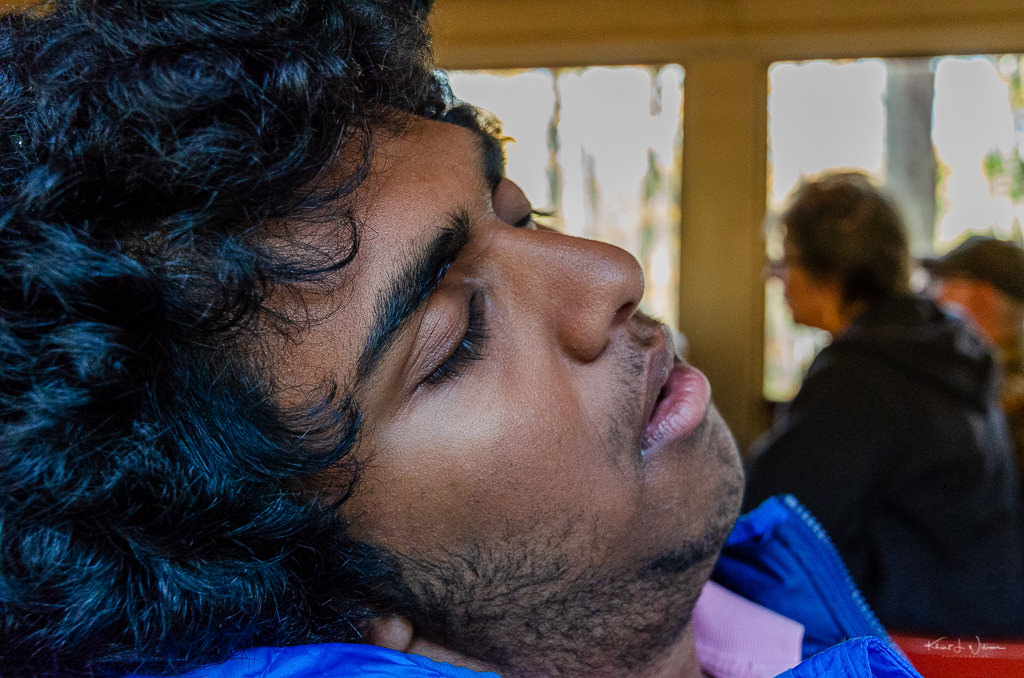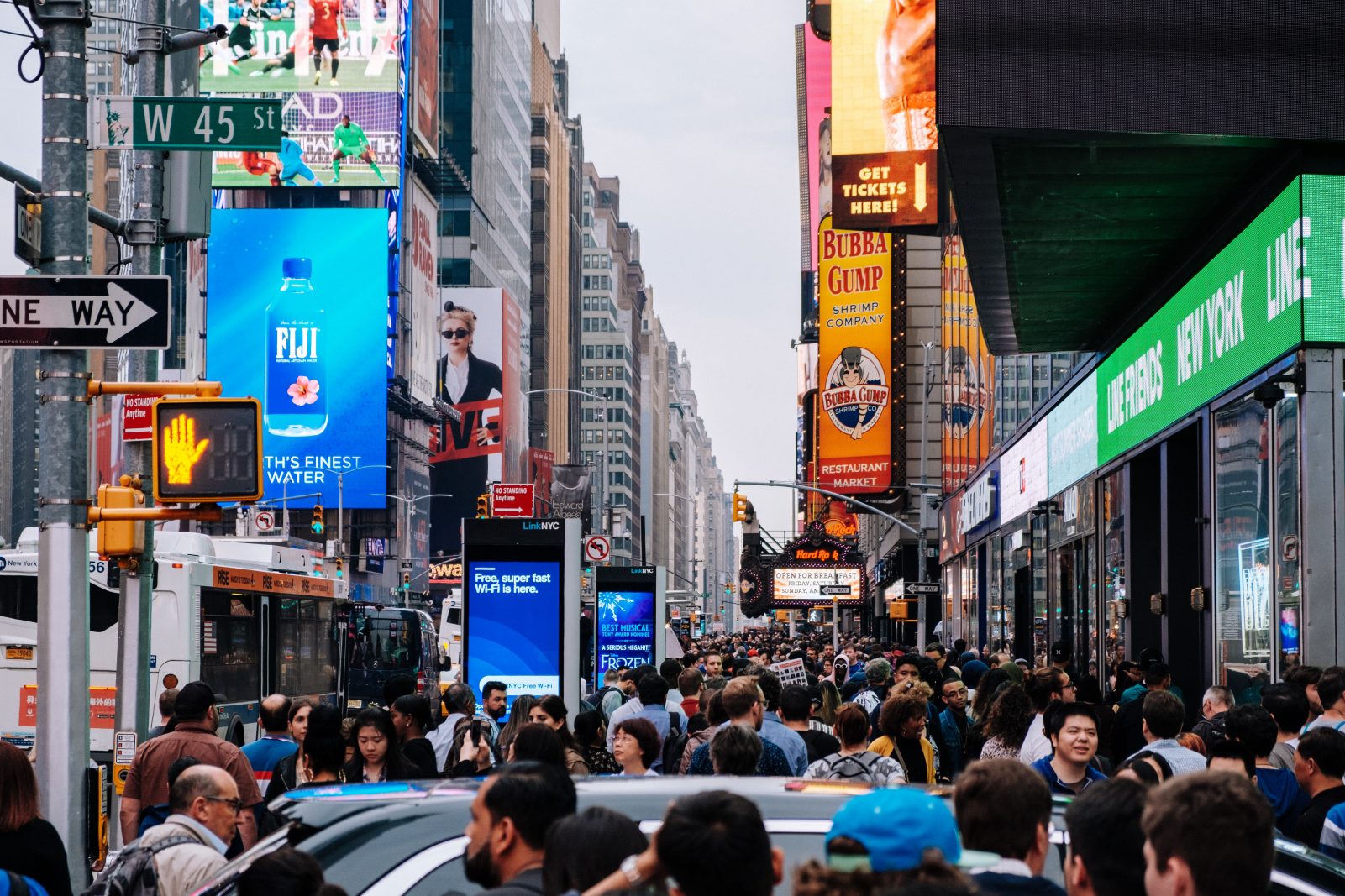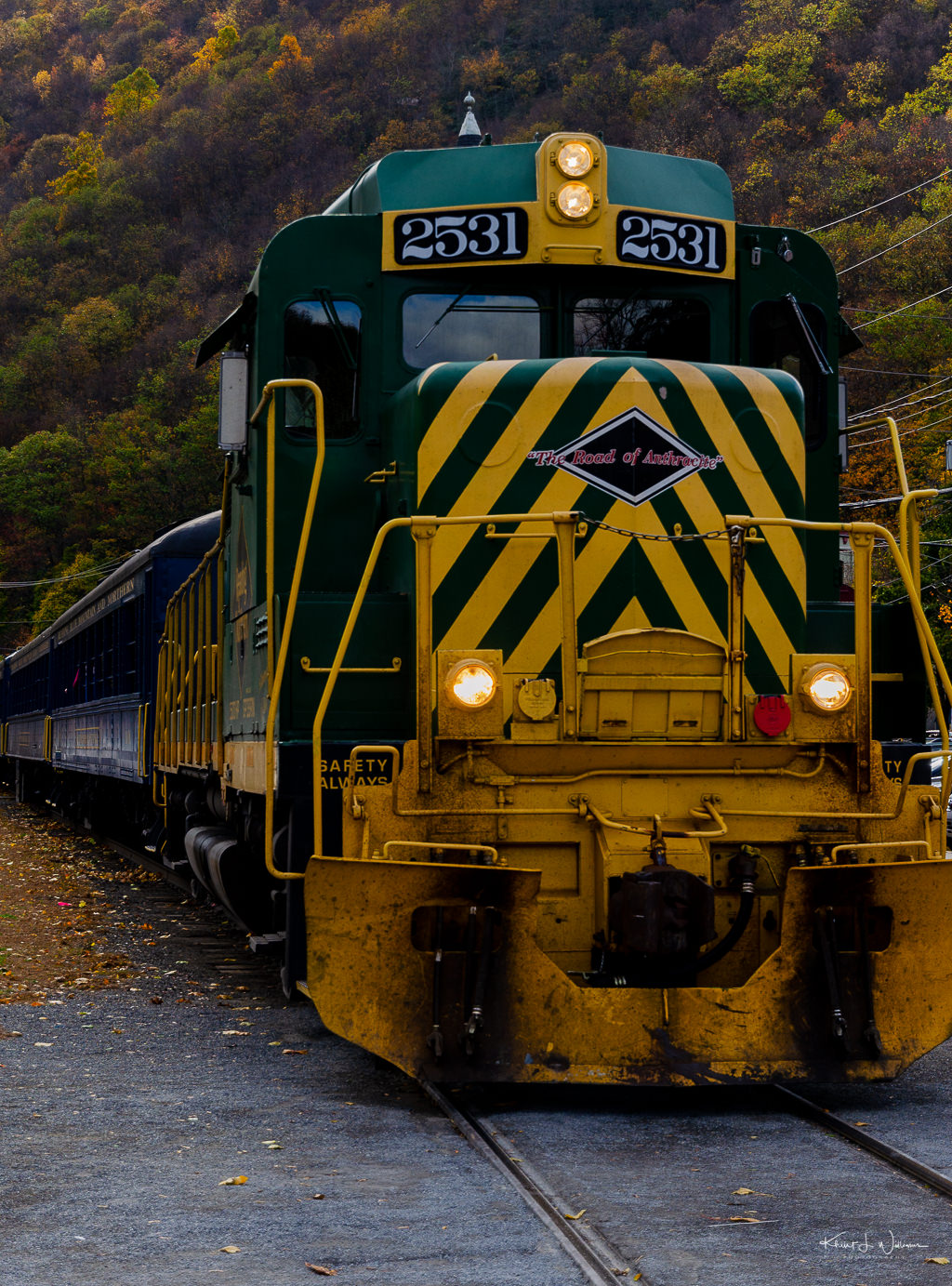Wow. I can’t remember the last time the platform looked this … “unoccupied”.
Tag: Train
New York City by car, bus, train, bicycle and on foot
Colin, I’m convinced that any initiative that doesn't take into account the unique nature of New York City will have unintended negative consequences.
The New York Times article is lacking in perspective. While I understand the desire to tame traffic and make walking and biking safer, and I applaud efforts to do so, most of the pedestrians in New York are not New Yorkers.
On any given day the number of arriving commuters ie equal in size to the local residential population of Manhattan. The United States Census Bureau Reports (2013) that 1.6 Million workers commute into Manhattan daily. Many of those commuters are from the towns in northern, and central New Jersey, southern Connecticut. Manhattan (also known as New York County) has among the highest number of commuters coming from another New York County (mostly Queens County, Brooklyn (Kings County), and Staten Island) in the nation. They arrive mostly via bus and rail but some do drive in.
The commuters -- I will be one of those commuters starting later this week1 -- arriving via New Jersey Transit are at the mercy of an aging transit system. A commute from Princeton to Penn Station (New York) via NJ Transit can take anywhere from 45 minutes to 90 minutes depending on whether one catches the express train (fewer stops) or the local train. An additional 30 minutes if you commute to downtown or near Wall Street. Recently NJ Transit has had many issues with the trains and the commute times have become unpredictable.
Despite so many constituents depending on the system, NJT has fallen into disrepair over the past decade. Years of neglect have turned NJT into an unpredictable and unreliable system to the thousands of commuters that use it every day.
….
In a given five day work week, you have a 94% chance of being delayed into New York Penn at least once.
A recent tweet from a friend who commutes to Manhattan.
Worst part of leaving NYC pic.twitter.com/WdEfYoZvi0
— (its).aneesha.kay (@itsaneeshakay) May 5, 2018
And the commute times are about to get worse.
Elise Young reporting for Bloomberg:
This month, NJ Transit said it would have to adjust weekday rail schedules beginning June 4 to allow for hardware installation. It’s scratching 14 routes, leaving riders to squeeze aboard earlier or later trains, some that already are often jammed with standees.
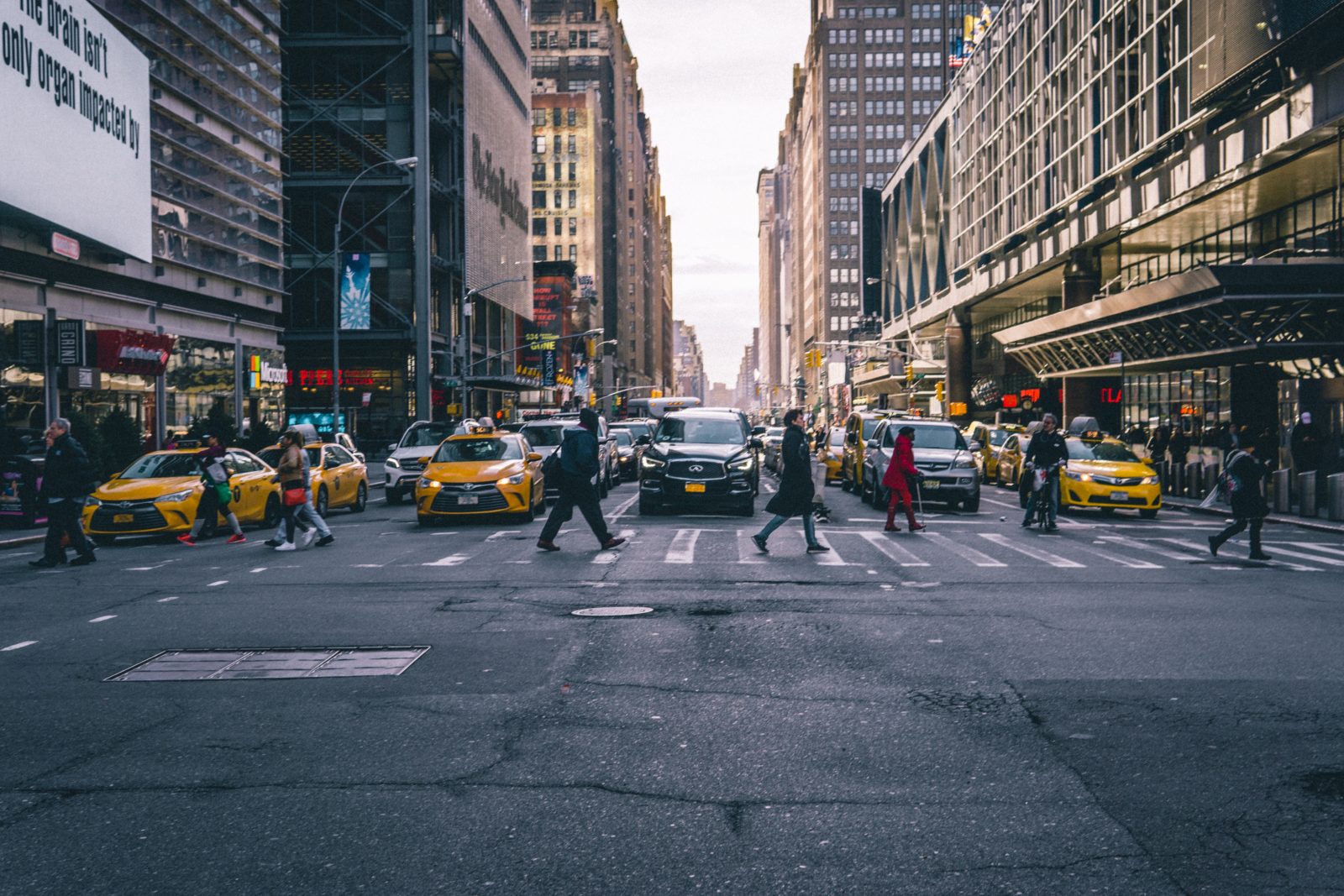
Image CC0 by Joseph Cooper on Unsplash
Driving into Manhattan is not without peril. You are often just one accident away from sitting inside a tunnel sucking in exhaust fumes.
But when I see traffic in New York City, my personal observation is that it’s mostly New York City Yellow cabs zipping people around town who want a more comfortable2 (and often faster) ride or for whom depending on the transit system to get them into the city is a non-starter.

When my kids were younger we often visited the city, mostly to the American Museum of Natural History. We would finish our day with a leisurely walk through Central Park. I didn’t want to deal with the hassle of parking so we always took the train from Princeton Junction and then a subway ride that delivered us right inside the museum. We would leave the Princeton Junction train station around 9 AM and arrive in the museum about 90 minutes later. That same trip with the current NJ Transit schedule would take over two hours. I haven’t been into Manhattan in a few years. I’d rather drive to Philadelphia (45 minutes). The distance driven is the same.
And I’m not sure that the European cities mentioned in that New York Times article are a good model for New York City.
Copenhagen may have a justified reputation as a cyclists’ paradise, but over the past three years, something shocking has happened: The proportion of bike commuters on the city’s roads has been going down. Since 2014, the share of commuter trips made by bike has dropped by 4 percentage points, from 45 percent in 2014 to 41 percent now. The modal share for bikes for all journeys, meanwhile, has stagnated. Currently, 24 percent of all trips in the Danish Capital Region take place by bike, a rise of just 0.2 percent since 2012.
And Paris
Unsurprisingly the research by the RegionsJob site, which showed that just over three-quarters of people working in the French capital are ready to earn less for an equivalent position in exchange for a shorter commute, also shows strong disparities between the Paris region and provincial cities.
Public transport is used far more in Paris, with cars only accounting for 29 percent of commutes while this figure is reversed in other parts of France, the study showed.
So what does all of this have to do with reducing road speeds and making New York City streets safer for bicycles and pedestrians? Perhaps nothing. I am just pointing out that most of the pedestrians and drivers in New York City are commuters from other states and boroughs. And while they won’t argue against safety, I think most of them are more concerned with more efficient ways to get into Manhattan for work.
Speaking to a local radio station earlier this year, the general manager of L.A.’s Department of Transportation, Seleta Reynolds, said the fundamental questions for L.A. are the ones one that many cities are grappling with: Are city streets for the residents who live in the immediate neighborhood, or the commuters who use them to get somewhere else? And which users should get priority—the ones behind a steering wheel, or a handlebar? How to Kill a Bike Lane
Bicyclers in New York City are their own worse enemy. 5,000 Bicyclists Busted For Running Red Lights In 2018.
The NYPD says it has busted nearly 5,000 cyclists in the first four-plus months of 2018 for running red lights, which is a few hundred more violations than at the same time last year.
The Department of Transportation has installed more than 100 traffic lights specifically aimed at bicyclists. To avoid collisions, bike riders are given the green light about six to 10 seconds before vehicle traffic headed in the same direction.
Almost all of the lights are in Manhattan.
According to the New York Times:
New York City is in the midst of a cycling boom. New Yorkers are riding bikes more than ever, both as a commuting option and a recreational activity. But with that growth has come a steady increase in the number of riders who flout traffic laws, ignoring the fact that their actions can have tragic consequences.
I know this firsthand. On March 9 at about 6:30 p.m. in Washington, my mother, Jane Bennett Clark, stepped onto the street on her way to the subway after work. It was an unseasonably warm and beautiful day, and I like to think that as she stepped off the curb she was in a cheerful mood, thinking about the weekend ahead.
Those were among her final conscious moments.
Seconds after she set foot in the crosswalk, a cyclist plowed into my mother with such speed that he broke her collarbone and multiple ribs. (My mom, who followed pedestrian laws with a near-religious fervor, had a green light.) She fell back on her head, fractured her skull and lost consciousness soon after. The cyclist was cited for disobeying a traffic device. The next day, my mother was declared dead at the hospital.
She was 65, a journalist, a mother of three, a partner, a daughter and a new grandmother.
My mom was struck in Washington, but it could have happened in New York. Both are among the most bike-friendly cities in the country. As The Times reported last month, there are more than 450,000 daily bike trips in the city. With 10,000 Citi Bikes and ubiquitous bike lanes, the streets are more hospitable than ever to bicycle commuters. And those increases aren’t unique to New York. Between 2000 and 2013, bike-commuting rates increased 62 percent on a national average, according to the League of American Bicyclists.
Perhaps that’s why I’ve come to refer to New York City as the “Zoo”.
- The client company is transitioning from Manhattan to New Jersey but due to a lack of parking at the New Jersey location I am required to report to the Manhattan location temporarily. ↩
- Have you ever stood on a crowded subway platform in the heat of July and August in a full suit and tie waiting ten minutes for a train? You’d better be fit, use really good deodorant and be properly hydrated. ↩
Autumn Leaf Excursion to Jim Thorpe on the Lehigh Gorge Scenic Railway
My son loves trains, so he was excited. When he was much younger (and shorter), we often visited the New Hope and Ivyland Railroad (especially when Thomas was visiting) and the Railroad Museum of Pennsylvania. We travelled to New Hope, Pennsylvania, a lot when he was in pre-school because I was out of work for nine months in 2001. We had a lot of father-son time.
Last year when my friend, Ed Velez, mentioned that he loved trains and suggested I take a ride from Port Clinton, PA to the historic town of Jim Thorpe on the Lehigh Gorge Scenic Railway, I put the date on my calendar. Ed had ridden the train two years prior. I knew the experience was well recommended, so I bought my tickets in later summer for the October diesel autumn leaf excursion. The tours were sold out, so I can only assume this is a favourite activity.
Excitement
I was excited about this trip, and I hope this excitement is captured in my writing. A while ago, while out on one of many photos walks, I got into a conversation about the historic towns of New Hope, Lambertville, and Frenchtown along the Delaware River between New Jersey and Pennsylvania. I don't remember the details, but I do remember a woman recommended that I visit Jim Thorpe. She was from the town and gushed about how much I would enjoy photographing the town. I remember going home and clicking through the many beautiful images I found on Flickr. Stunning. I think the topic of Jim Thorpe came up because this woman had seen one of my holiday pictures taken during a snow storm over Frenchtown. In any case, I was determined that someday I would make it out to Jim Thorpe for photography.
As the day of the excursion approached, I grew a bit nervous. The leaves in my town had already started to yellow and redden. I was concerned that the foliage along the train tracks would be brown and dull by the time we took our trip.
Gear
I planned out every detail of our trip, including when and where to eat lunch, what streets to walk, and which building to photograph. I wanted to capture the feeling of a small European village. I didn't want to carry a lot of gear, but I wanted to be sure I could have enough coverage for wide scenes and group portraits. Bringing my Nikon 35mm f/1.8, 85mm f/1.8 and 18-55mm f/3.5-5.6 would have added a lot of weight to my camera bag. I rented a Nikon 16-80mm f/2.8-4E ED AF-S DX VR. It's one of Nikon's newest lens. It's versatile enough to capture most of what I may see while touring Jim Thorpe. The rest of the camera bag will be filled with lens wipes; an iPhone flash mounted tripod, an extra battery and a camera remote.
Outbound
We left our home around 6:45 AM and arrived at Port Clinton around 8:30 AM. Ed texted me his location on the train, but we first had to work out an issue with tickets. The issue? We didn't have our tickets. I thought that perhaps they had forgotten to send them to me. The ticket booth person insisted that they had been mailed out weeks before. It was only after returning home that night and looking around that I found them in the filing folder. Fortunately, I had kept a copy of the receipt in the car. The ticket booth attendant issued handwritten tickets so we could board the train.
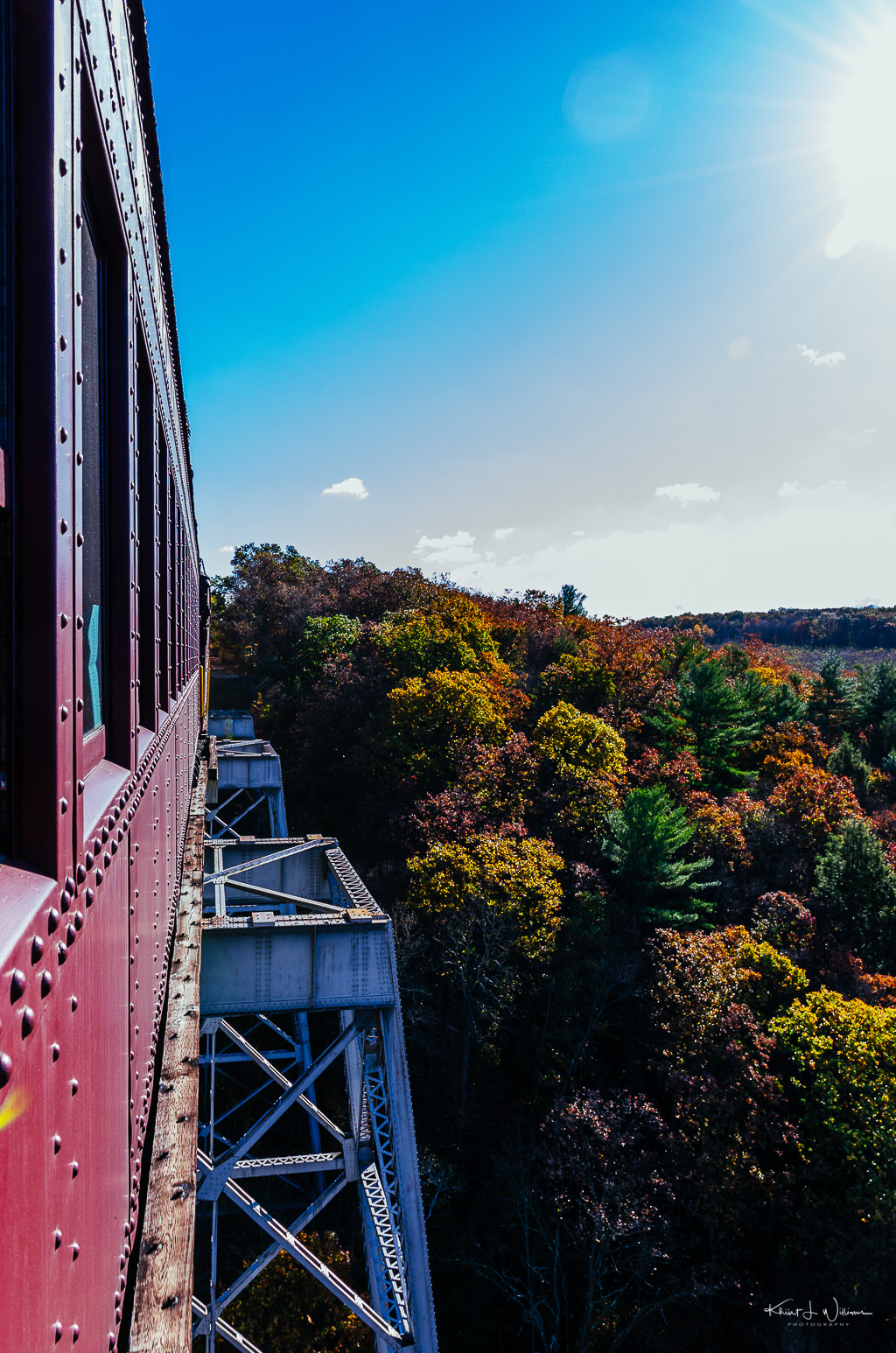
Our train had both red and blue standard coach cars. We rode in one of the red coach cars, which, according to the website, was built in 1917. Our seats were comfortable. Ed had arrived early and snagged a window seat that can be opened or closed. These coaches also have restrooms.
The train was filled. I enjoyed chatting with Ed and my family as the train pulled through one historical small town after the other. Our train host called out the names of the towns and a quick history lesson on each as the train slowly made its way to Jim Thorpe.
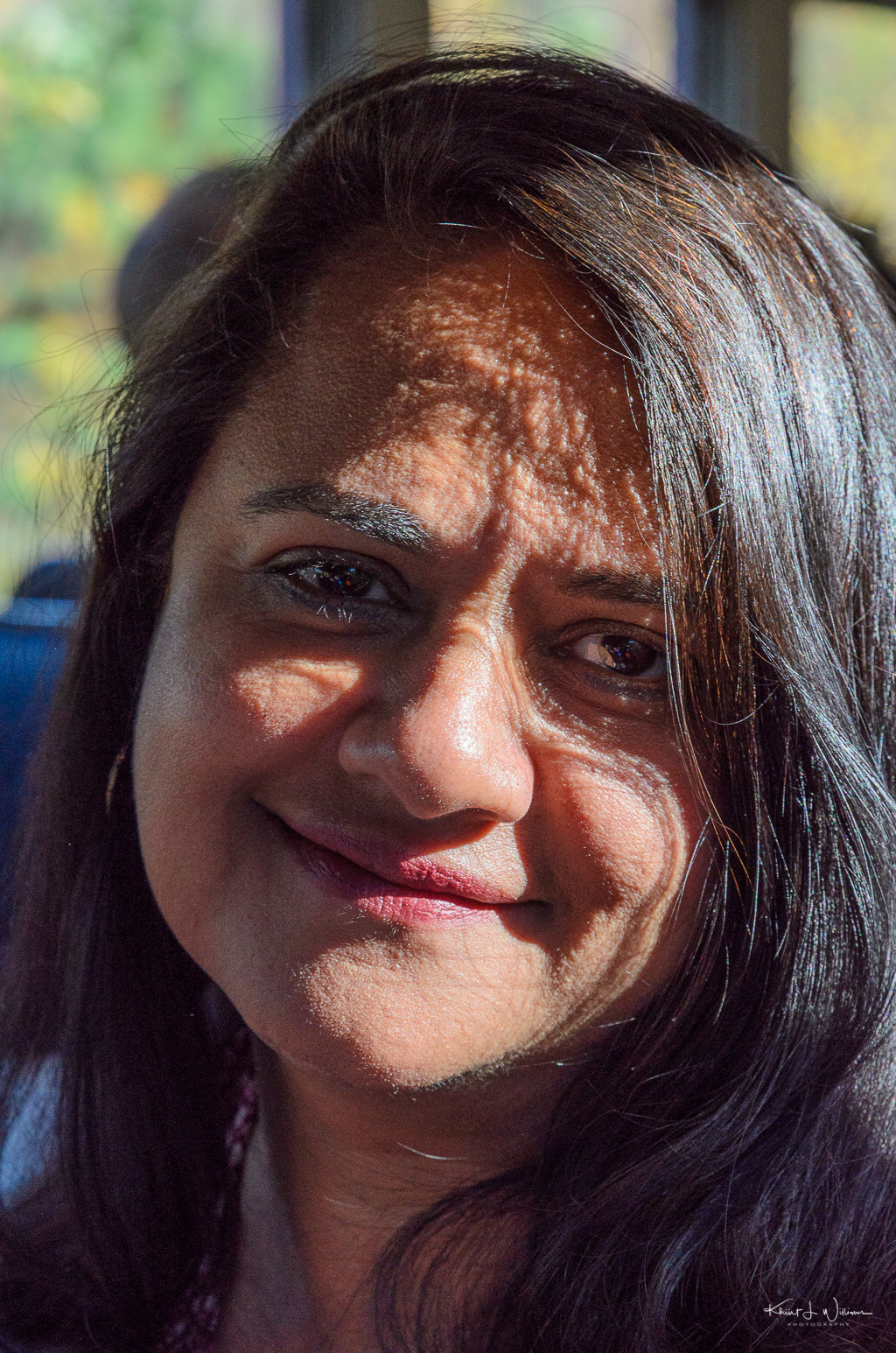
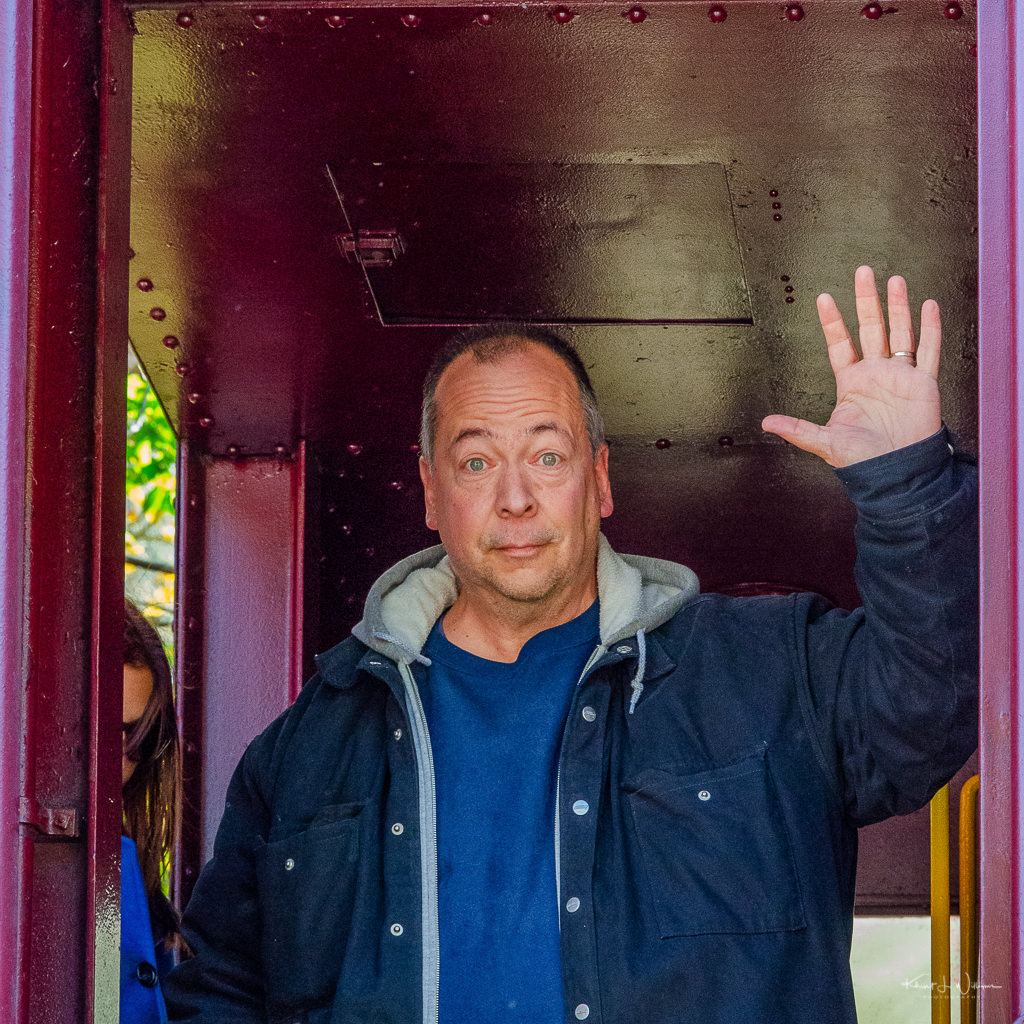
I saw the beautiful colours of fall while the train crossed the High Bridge through Hometown. Our train travelled along Lake Hauto. Ed and I opened the windows so we could stick our cameras outside. The air was crisp and sweets. If we had taken the steam train ride, I am sure the smell would have added an even more nostalgic feel to the experience.
It was a challenge for me to keep the camera steady while shooting out the window of a moving train. I had a slight pang of dread at the idea of my camera popping out of my hand and falling into the valley below. The High Bridge is 168 feet tall and 1,000 feet long. Thank goodness for hand-straps.
Two hours later, our train pulled into the Central Railroad of New Jersey Station at Jim Thorpe.
Arriving in Jim Thorpe
Before being renamed to honour legendary athlete James Francis Thorpe, the town was formerly known as Mauch Chunk. Mauch Chunk is a Leni Lenape Indian name that means "Bear Mountain." The train pulled into the middle of town, and we could see the mountains all around us as the train pulled into the station.
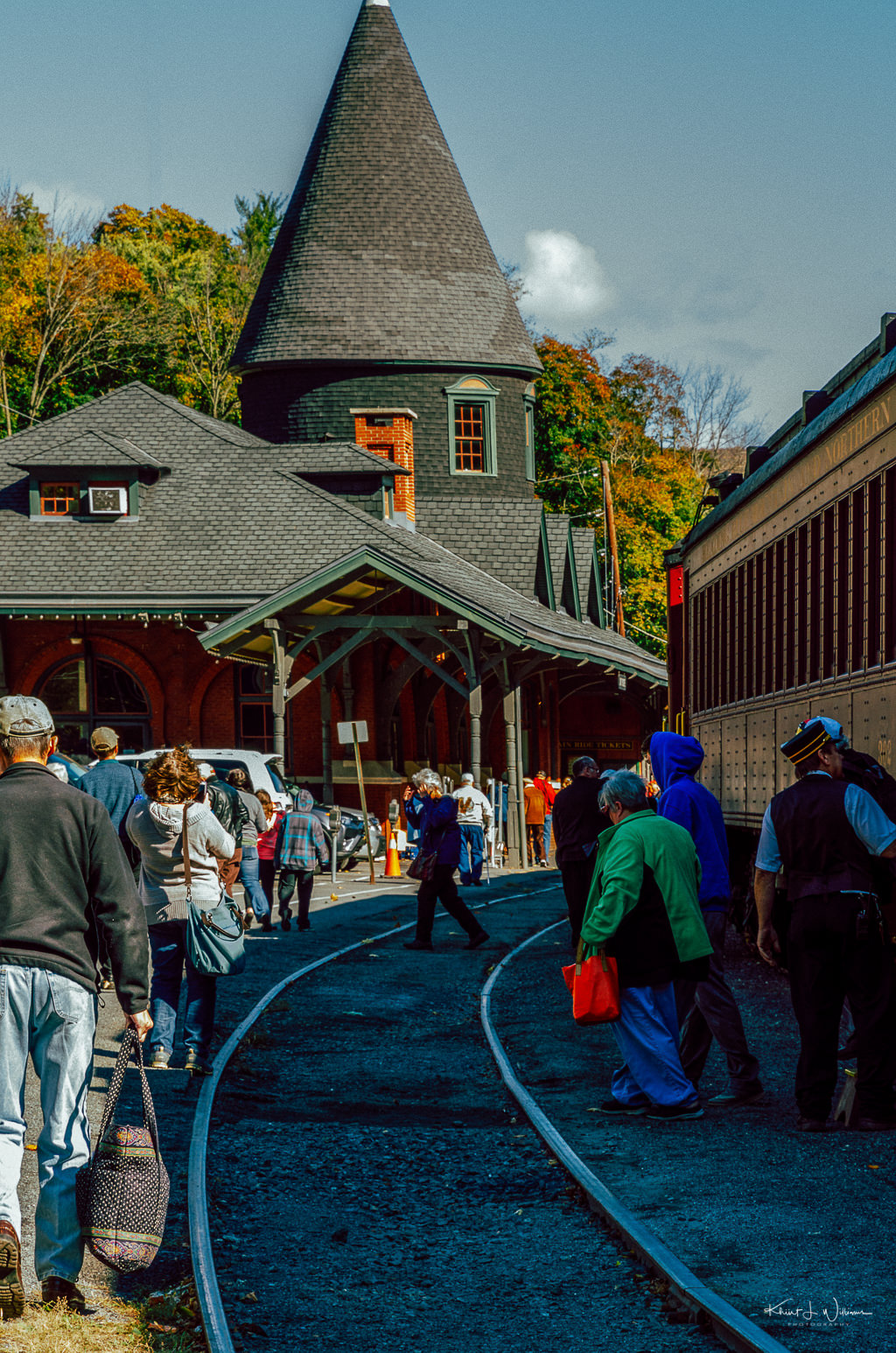
We disembarked at Jim Thorpe Station and walked toward the station building. On January 1, 1976, The Central Railroad of New Jersey Station, also known as the Jersey Central Station and Jim Thorpe Station, was added to the National Register of Historic Places. The station was designed by Wilson Brothers & Company of Philadelphia, Pennsylvania, and built in 1888.
There were vendors outside selling baked goods which reminded me that I planned to eat at Stone Row on Race Street. I had contacted the restaurant a few weeks earlier and promised to be first in line when they opened at 11:30 AM. I corralled the “troops”, and we made our way toward and up Race Street.
I wanted to stop at the Big Creek Vineyard and Hooven Mercantile Co Museum, but we were in a rush.
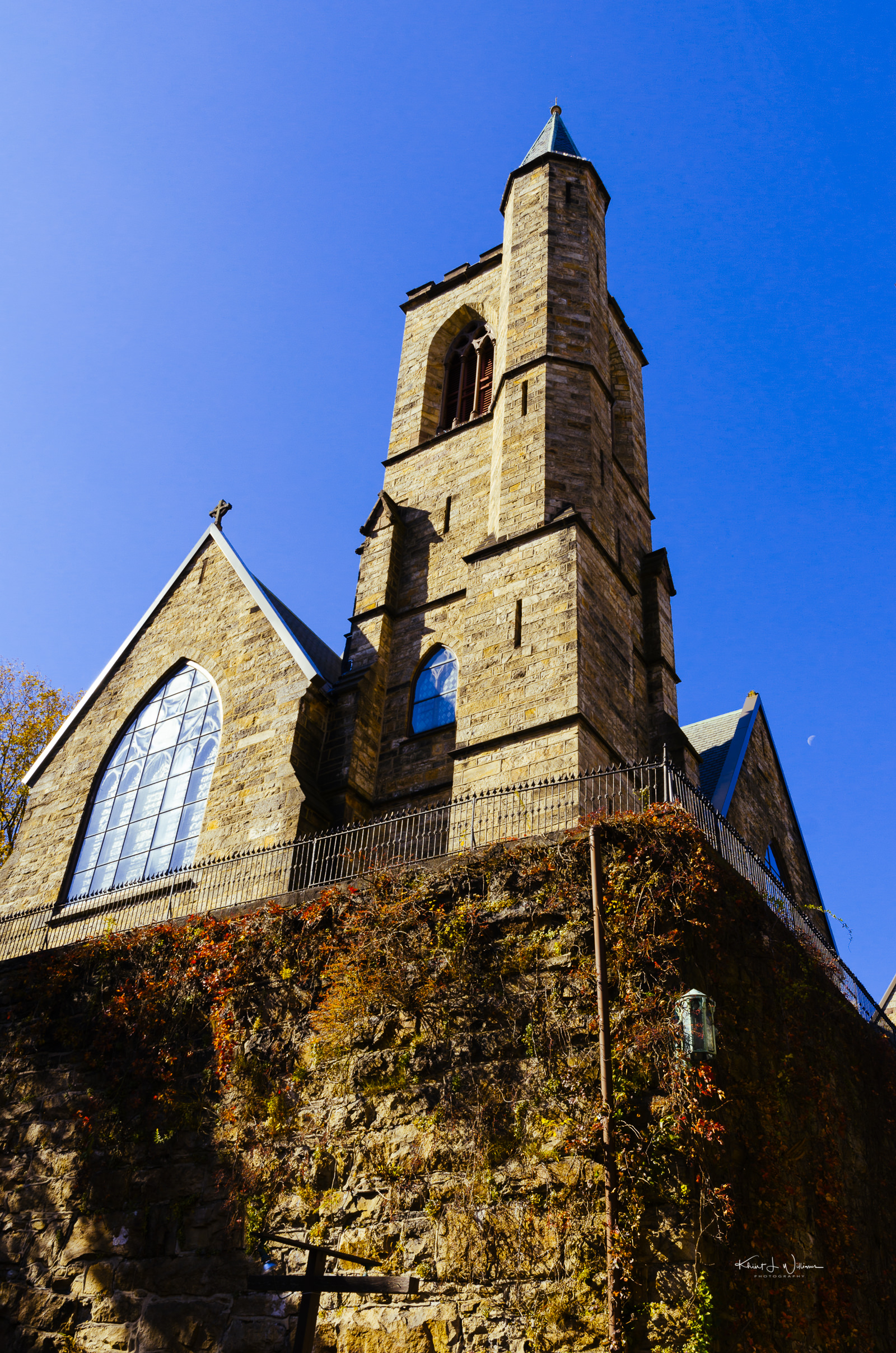
We made our way up — Race Street is slightly inclined — passing the St. Mark’s Episcopal Church. The church was designed by British-born American architect Richard Upjohn between 1867 and 1869 in the Gothic Revival style. Ed and I were slowly moving, snapping photos along the way. Stopping to take pictures is most likely what caused us to arrive late than expected at the front door of the Stone Row Pub.
Race Street is narrow — most of the streets in Jim Thorpe are narrow — with terraced gardens and door flags that made the street look like what I think a street in a small European might look like. The homes are a blend of Victorian architecture with quaint small street-front businesses. And electrical wires everywhere. I was not too fond of these electrical wires. To me, they ruined the look of the street. I wish they were all underground. But you won’t find many wires in my images. I took the effort to remove them in Photoshop. I know it doesn’t reflect the reality of Jim Thorpe, but I like these photos better.
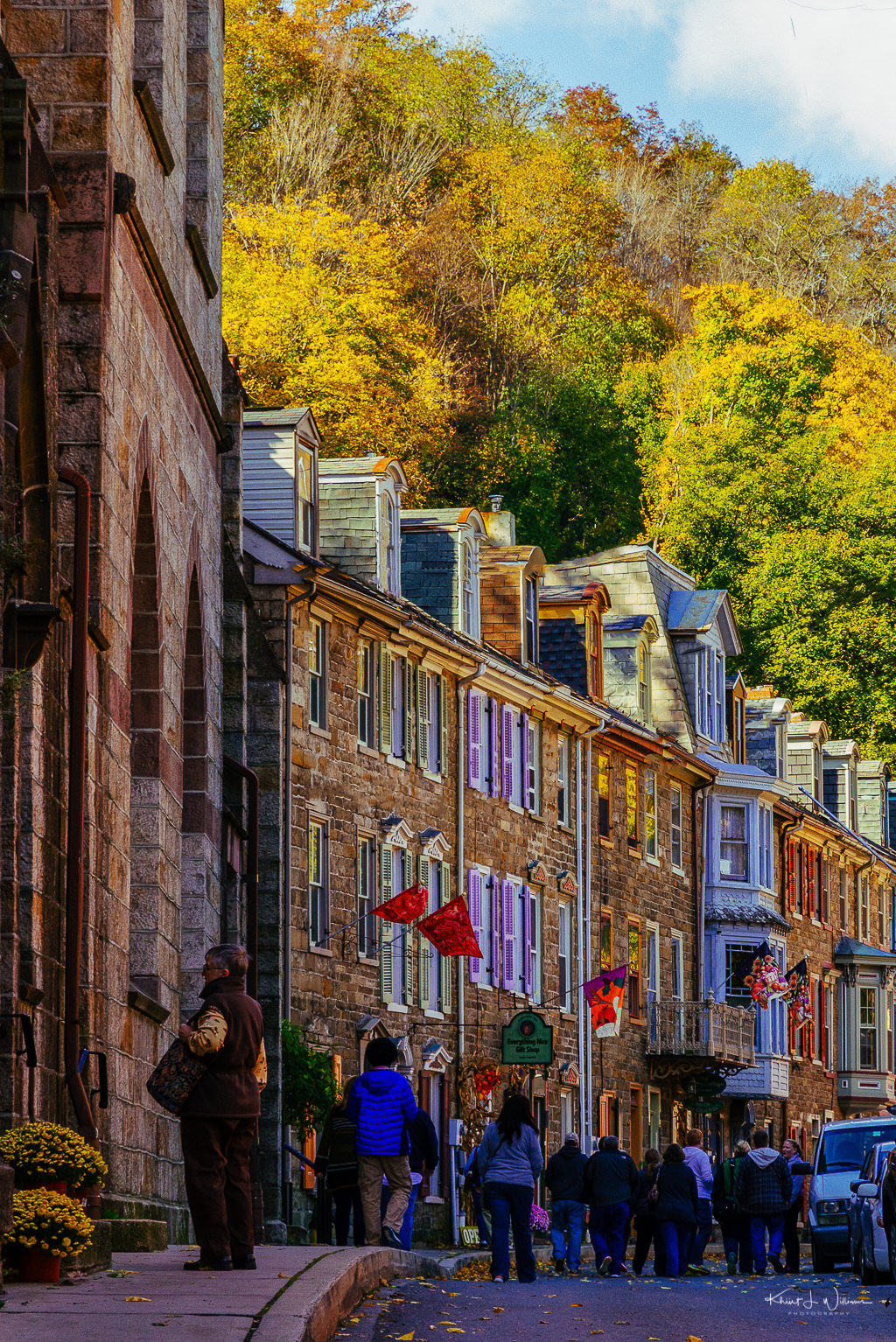
We finally made it to the Stone Row Pub only to discover a line had formed just inside the doorway. It seems the Stone Row Pub is quite small, and all meals are “made-from-scratch”. It can seat only twenty people. Twenty people were already seated, and a quick count showed about ten people in line ahead of us. We were hungry after our two-hour ride on the train, so we opted for plan B, which we created "at the moment". We walked to the end of Race Street and found another place to eat.
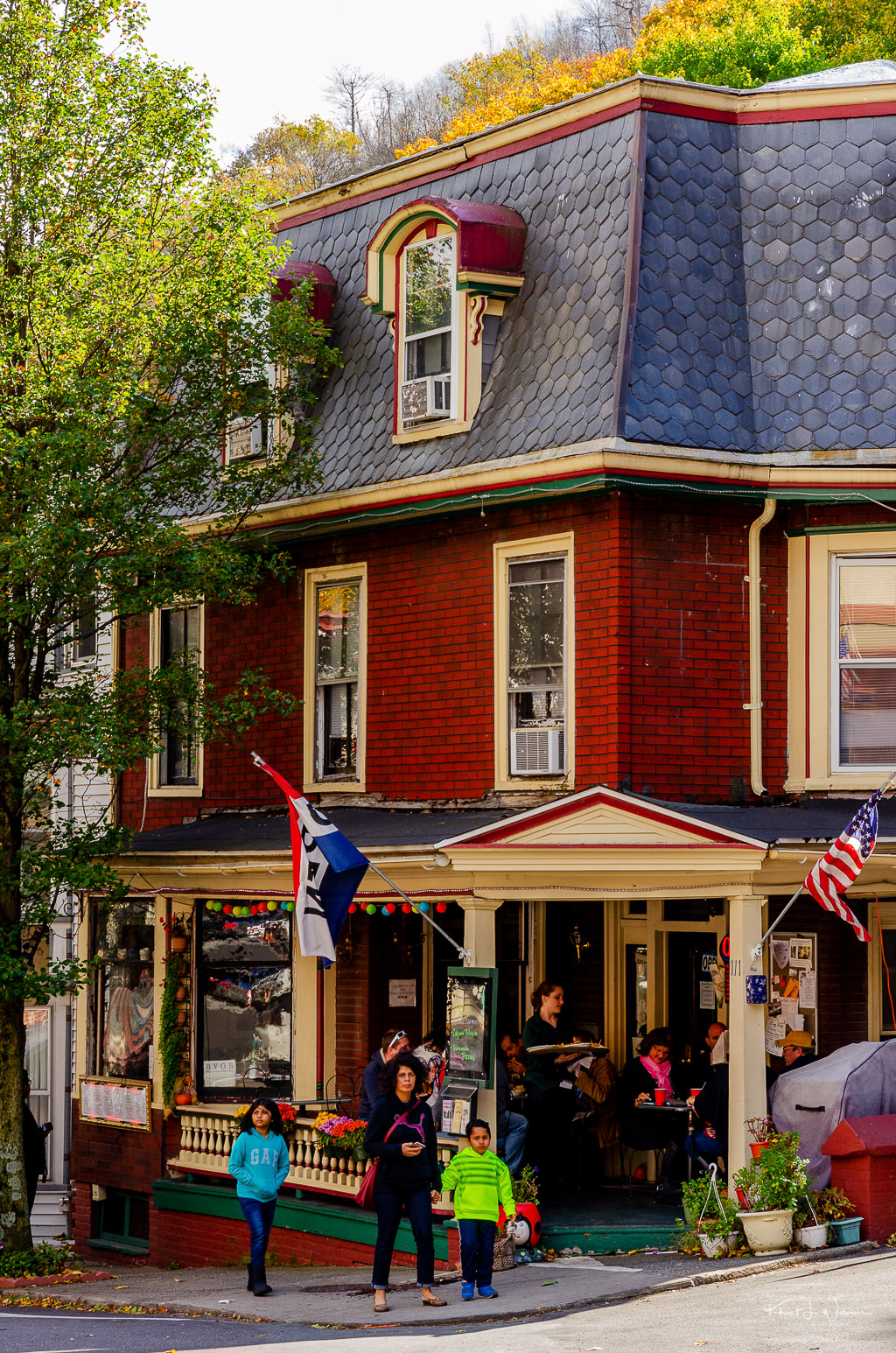
We had lunch at a restaurant called Through the Looking Glass, on the corner of Race and Broad Streets near the Mauch Chunk Opera House. It is the older restaurant in Jim Thorpe. I think the restaurant's theme is loosely based on the Lewis Carol novel of the same name. I don’t know for sure.
While we waited for our food to arrive, we enjoyed the acoustic guitar music played by a local musician. After a quick breakfast — it was almost 12:30, but we had pancakes, eggs, toast, bacon, etc. — we made our way to the Mauch Chunk Opera House. I didn’t include photos of the opera house because … well, I only got one. It was very dark inside, and my attempt at HDR was not quite what I wanted.
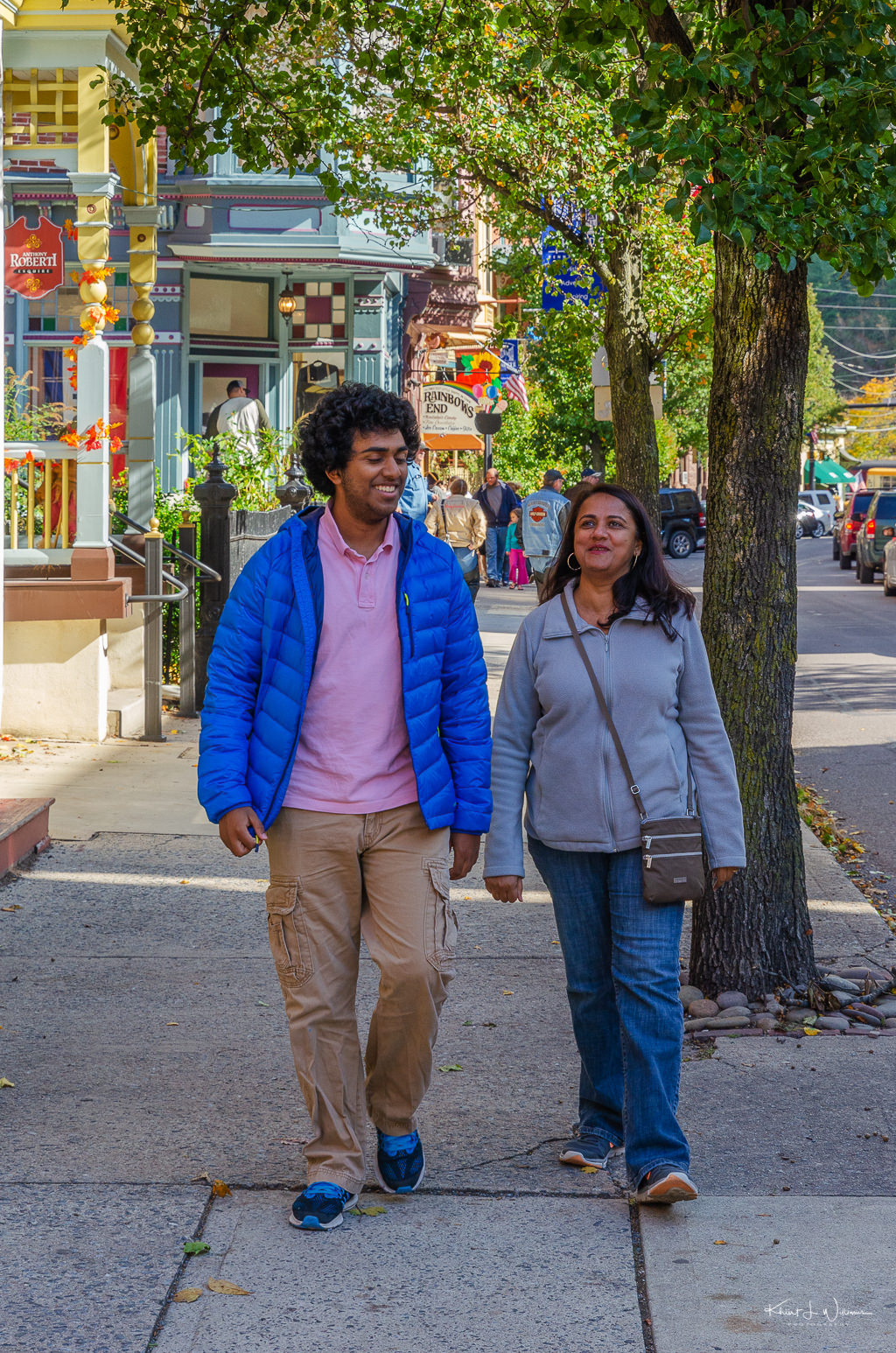
We exited the Mauch Chunk Opera House and made our way slowly down Broad Street enjoying the windows of the quaint little shops. We stopped in at one place, House of Jerky, selling various exotic meat and vegetarian based jerky. Kangaroo and Shark?
I passed a couple sitting outside the Jim Thorpe National Bank. I did something that I seldom do. I asked if I could take their photo. Is it still street photography if I ask for permission? My only regret is not having a card to give them to contact me for the picture. I want to be better prepared for this.
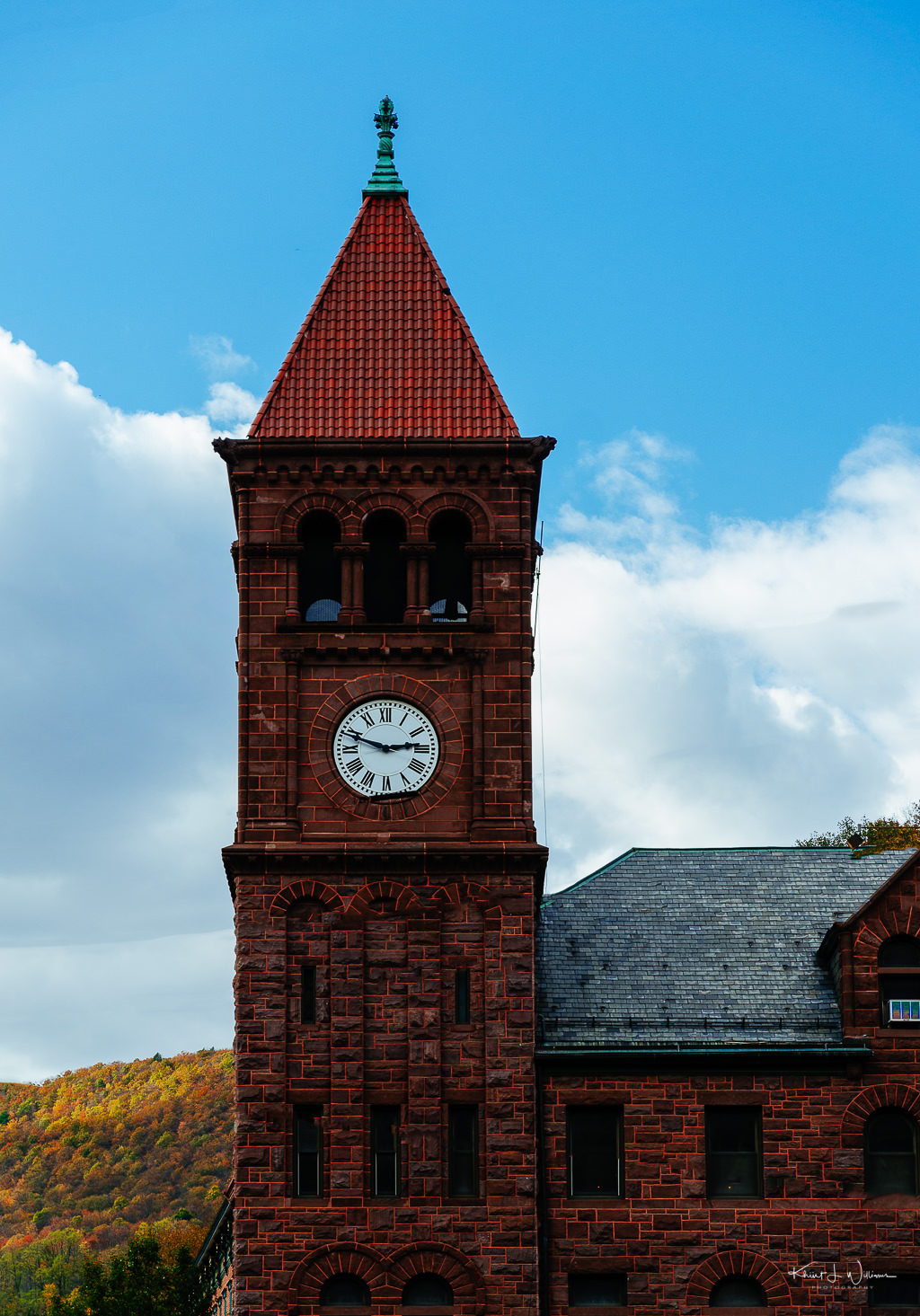
We were past the Carbon County Court House, turned left onto Hazard Square, and walked up a steep set of stairs onto Packer Hill Avenue toward Asa Packer Mansion Museum. Who’s Asa Packer?
I didn’t get the shot of the Asa Packer museum that I wanted. I had this belief that I could somehow get a panoramic view of the house looking from higher up the hill. The reality is that the house is wedged in on a plot of land on the side of a steep hill, looking down onto the rooftops of the streets of Jim Thorpe.
I took some portrait shots of Bhavana and Shaan sitting on a metal bench chatting. While they chatted, I walked up to the entrance of the Asa Packer building and stood next to a statue of a deer dressed in holiday clothes. While admiring the deer's clothing, I looked up and saw somewhat appeared to be smoke in the distance near Race Street. While standing there looking down into town, I saw the light come over the hill and illuminate the church town. I quickly set up my tripod and captured my favourite photo of the day.
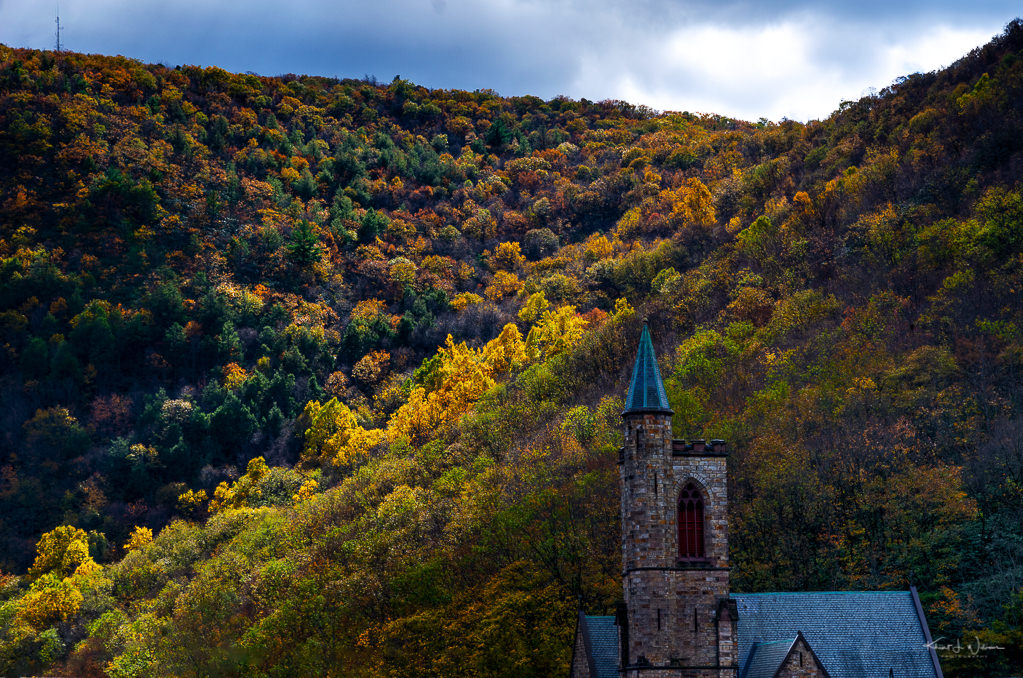
We walked back down Packer Hill Avenue to the train tracks on Lehigh Avenue. Ed and I wanted some photos of the trains. Ed knew that the High Bridge train would be returning soon, and we would get some shots of the train pulling into the station. Bhavana and Shaan split off to look for restrooms and to shop at the vendors we had seen earlier when our train stopped at the station.
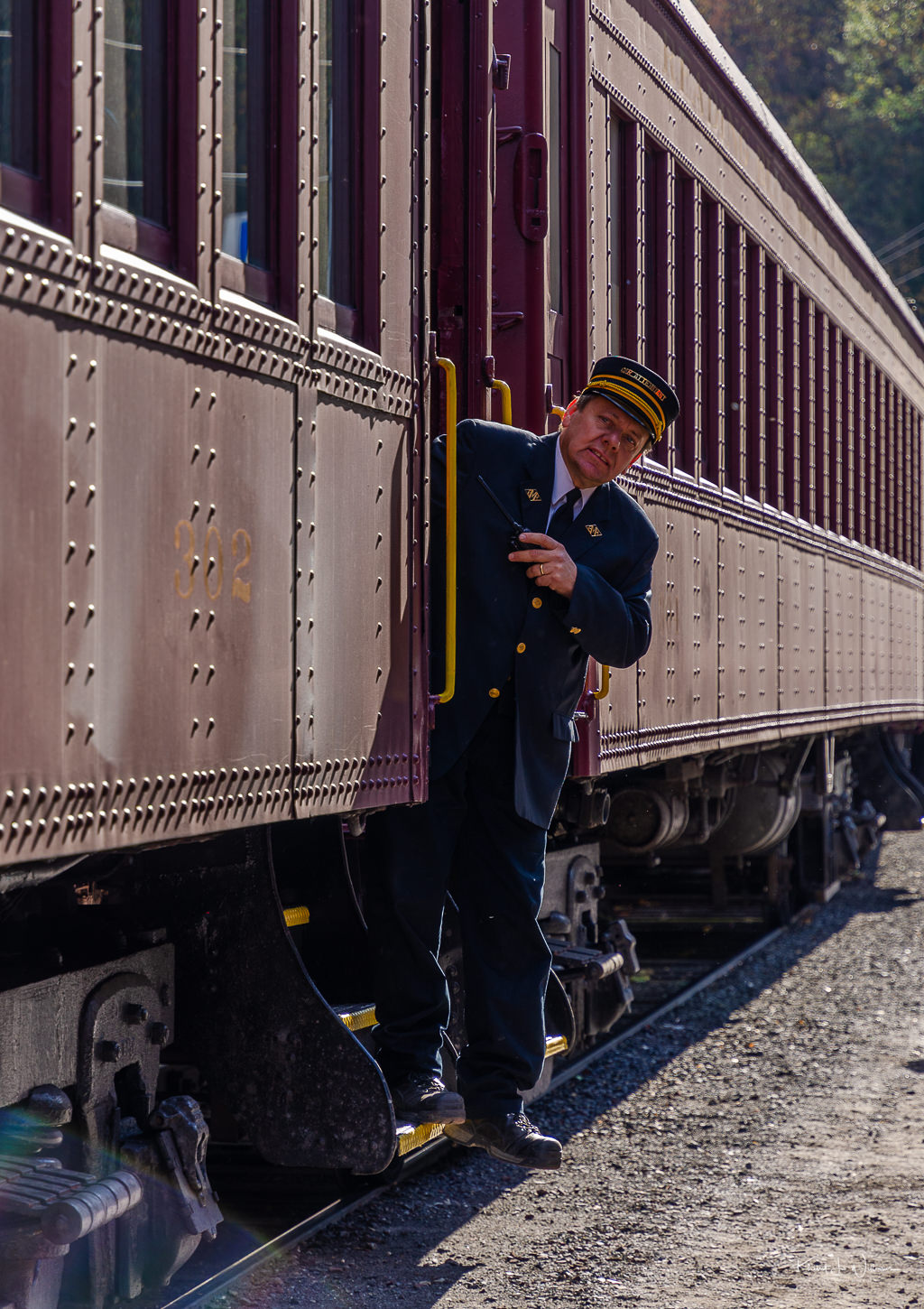
The train tracks are where Ed and I spent most of our time snapping shots of the trains.
Bhavana and Shaan caught up with us just as our return train to Port Clinton pulled into the station.
On our way back, our train was delayed. The Lehigh Gorge Railway tracks and actually owned by a freight company. There was some miscommunication, and a freight train ended up on our track. Ed had a walkie-talkie, and we listened in on the conversations between our train crew, the station master, and the freight train conductor. It was highly entertaining. We had to wait for the freight train to back into a side track so that we could pass.
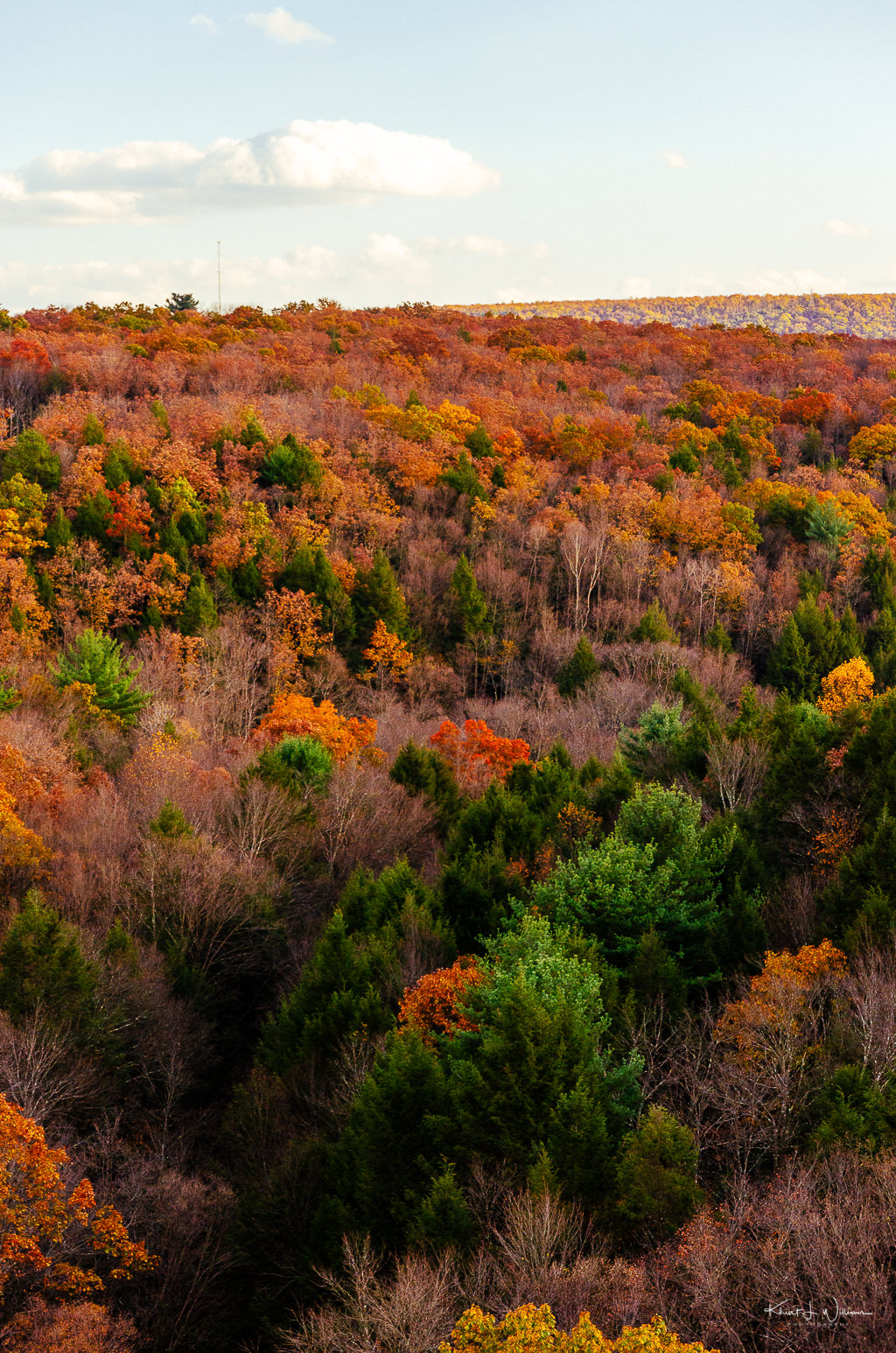
Once our train got started again, Ed and I opened the window to capture some of the images we could not capture on the outbound trip. Our train passes through an area that has two S curves. On the return trip, shooting out the window, we could get photos of the back and front of the train looping around the bend.
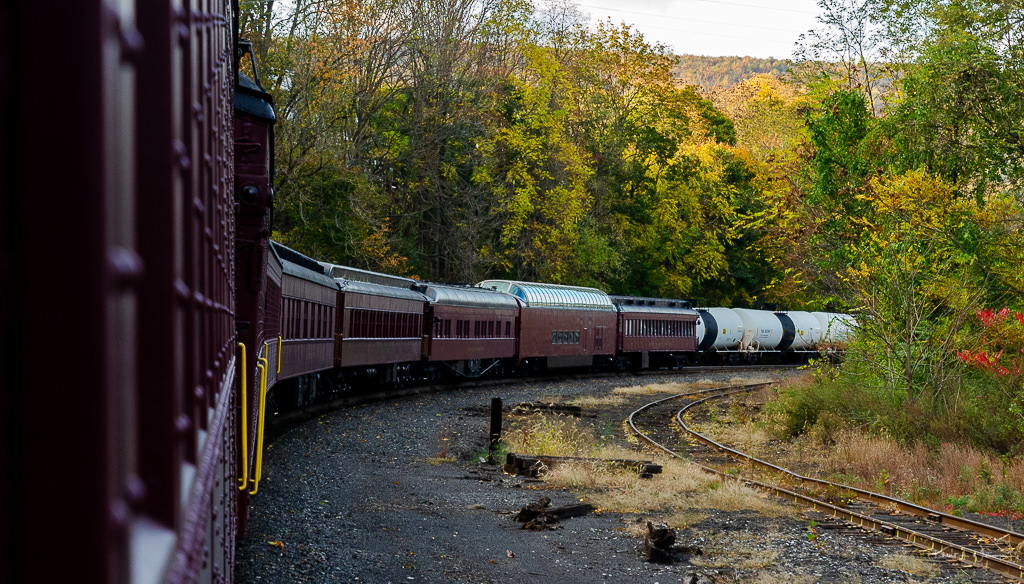
We were also much closer to the front of the train. I could hear the train whistle as we pushed through each town. Hooo Hooo! Hooo Hooo! God, I love that sound. I felt like a kid. I stuck my Nikon out the window to capture the sounds, but the whoosh of the window around the camera microphone was too loud.
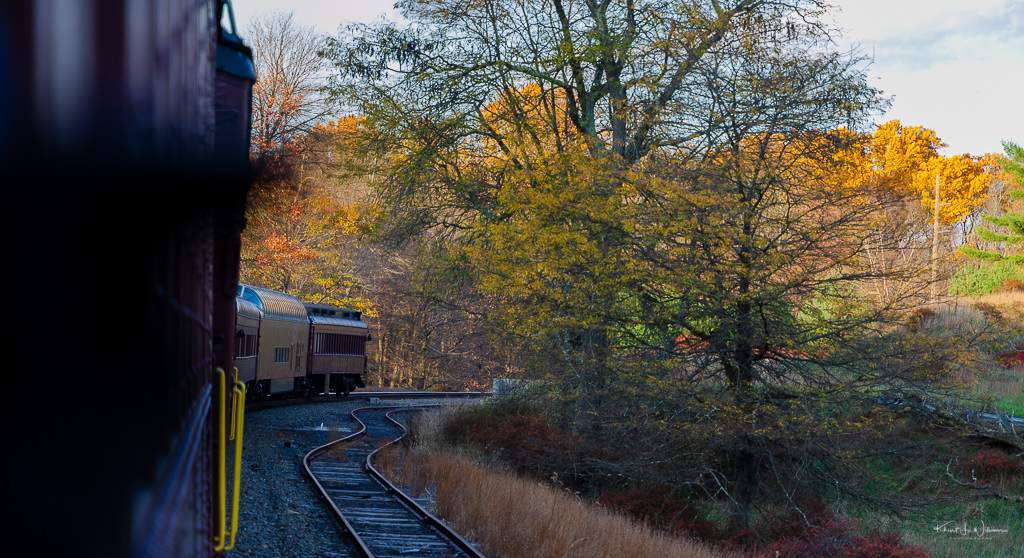
When choosing images for this photo essay, I had difficulty deciding which ones to include. I chose over two dozen pictures and agonised over whether was too many. As I wrote this article, I realised that I was stressed about it probably meant I should follow my instinct. I decided that I would choose my favourites and just enough to tell the story. The rest you can view on my Flickr page.
For each image, I applied either a Fuji or Kodak film preset and adjusted as needed.
I enjoyed my trip to Jim Thorpe and would definitely do this again. I think I can convince Bhavana to spend a night over in Jim Thorpe. I clicked a link on the Lehigh Gorge Railway website to get more information about the bike train and discovered that we could do an day event called the Big Day Out, which includes biking, hiking and raft along the Lehigh Gorge in one day!
